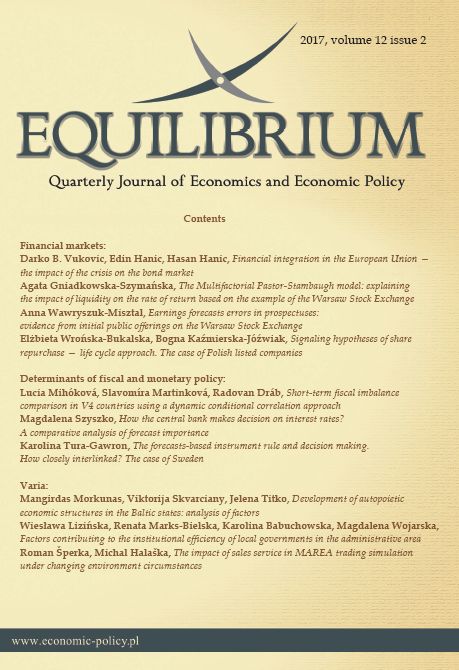EARNINGS FORECASTS ERRORS IN PROSPECTUSES: EVIDENCE FROM INITIAL PUBLIC OFFERINGS ON THE WARSAW STOCK EXCHANGE
EARNINGS FORECASTS ERRORS IN PROSPECTUSES: EVIDENCE FROM INITIAL PUBLIC OFFERINGS ON THE WARSAW STOCK EXCHANGE
Author(s): Anna Wawryszuk-MisztalSubject(s): Economy, Financial Markets
Published by: Instytut Badań Gospodarczych
Keywords: earnings forecasts; initial public offerings; IPO; Warsaw Stock Exchange
Summary/Abstract: Research background: Several studies investigated the issue of accuracy of earnings fore-casts disclosed in IPO prospectus because of its importance in the investor’s decisions. Disclosing earnings forecasts can reduce information asymmetry and encourage potential investors to buy offered shares. The accuracy of earnings forecasts, and especially its deter-minants, was explored by some researchers, but for Polish companies such studies have not been conducted. Purpose of the article: The first objective of this study is to examine the bias and accuracy of earnings forecasts disclosed in IPO prospectuses by Polish companies attempting to be listed on the main market of the Warsaw Stock Exchange. The second aim of this paper is to identify the relationship between the absolute fore-cast error employed as a measure of earnings accuracy and a number of company specific characteristics such as company’s size, leverage, forecast horizon, managerial ownership, number of shares offered to investors (in relation to total shares before IPO). Methods: The empirical analysis were conducted on a sample of 102 domestic companies that performed IPOs on the main market of the Warsaw Stock Exchange during 2006-2015 and disclosed earnings forecasts in IPO prospectus. The forecast error (FER) and absolute forecast error (AFER) were adopted as a measure of accuracy of earnings forecasts. The non-parametric test was employed to achieve the adopted aims. Findings & Value added: The results show that, on average, the forecasted earnings exceed the actual earnings (i.e. the earnings forecasts are optimistic) and fore-casts are inaccurate. Moreover, the optimistic forecasts are more inaccurate than pessimistic ones. The findings of multiple regression model show that three independent variables may affect the level of absolute forecast error: the company’s size, managerial ownership and forecast horizon.
Journal: Equilibrium. Quarterly Journal of Economics and Economic Policy
- Issue Year: 12/2017
- Issue No: 2
- Page Range: 229-243
- Page Count: 15
- Language: English

